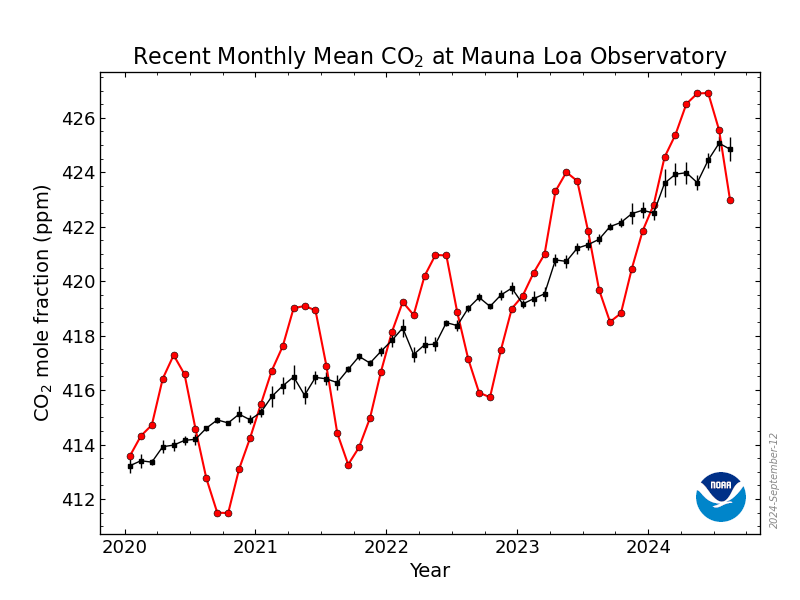The authors of this paper are Dagsvik and Moen.
Abstract
Weather and temperatures vary in ways that are difficult to explain and predict precisely. In this article we review data on temperature variations in the past as well possible reasons for these variations. Subsequently, we review key properties of global climate models and statistical analyses conducted by others on the ability of the global climate models to track historical temperatures. These tests show that standard climate models are rejected by time series data on global temperatures. Finally, we update and extend previous statistical analysis of temperature data (Dagsvik et al., 2020). Using theoretical arguments and statistical tests we find, as in Dagsvik et al. (2020), that the effect of man-made CO2 emissions does not appear to be strong enough to cause systematic changes in the temperature fluctuations during the last 200 years.
1. Introduction A typical feature of observed temperature series over the last two centuries is that they show, more or less, an increasing trend, see Appendix D and Figures B1, B6 and B7 in Appendix B.
"More or less"? If you want to get on someone's case about using technical terms, Dagsvik and Moen might need it.
A key question is whether this tendency is part of a cycle, or whether the temperature pattern during this period deviates systematically from previous variations.
So, apparently the timespan of interest is the last two centuries. What is not identified here is what is to be included within "previous variations". More significantly, we are not told why or how synthetic warming would deviate from natural varations.
Even if recent recorded temperature variations should turn out to deviate from previous variation patterns in a systematic way it is still a difficult challenge to establish how much of this change is due to increasing man-made emissions of carbon dioxide (CO2) and other greenhouse gases.
It's a "difficult challenge" particularly if the only tools in your box are statistical. Read that again. Is he not saying that they will be unable to robustly answer the very question they've set themselves?
At present, there is apparently a high degree of consensus among many climate researchers that the temperature increase of the last decades is systematic (and partly man-made).
The opposite of systematic is chaotic or disorganized. Random. Now, neither you nor I have these author's expertise in statistics, but we've both seen multiple representations of the global temperature over the last 2 centuries (and many other spans). Do YOU think the data trend of the last two centuries is random? Chaotic? Disorganized? And of course those data have likely been examined by almost every statistician on the planet. None, that I'm aware of, have suggested that the parameters of the warming trend observed preclude anthropogenesis.
This is certainly the impression conveyed by the mass media.
Why is a scholarly paper performing a statistical analysis on temperature data concerning itself with the mass media?
For non-experts, it is very difficult to obtain a comprehensive picture of the research in this field, and it is almost impossible to obtain an overview and understanding of the scientific basis for such a consensus (Koonin, 2021, Curry, 2023).
Non-experts? Who would that be? People inexpert in... climatology? People inexpert in atmospheric physics? People inexpert in atmospheric chemistry? People inexpert in geophysics? People inexpert in radiative thermodynamics? People like... the authors? And for some reason, in this very same sentence, they choose to bring up the consensus supporting AGW. Koonin is Dr Steven Koonin is a well-known physicist who worked as lead scientist for BP and in the Obama administration in the Department of Energy. He has had many interests during his career only one of which was environmental science and the climate. Curry is, of course, Dr Judith Curry. Koonin published NO scholarly papers on any topic in 2021. What he did publish was his book "
Unsettled: What Climate Science Tells Us, What It Doesn't, and Why It Matters". It is quite unusual for a scholarly paper to cite a commercially published work. Similarly, Curry published no scholarly papers in 2023. The Curry reference appears to be to one or more of the articles she has put up on her own website, eg:
Read the State of the Climate – Summer 2023 report for essential updates on global climate patterns, trends, and data-driven insights.

judithcurry.com
.
By looking at these issues in more detail, this article reviews past observed and reconstructed temperature data as well as properties and tests of the global climate models (GCMs).
What issues? Are they hoping to provide a comprehensive picture of research on global warming? Are they looking to validate the consensus? The title of this paper says they hope to determine, statistically, how much of the observed warming has been caused by increased GHGs in the atmosphere. And note that here we find the first mention of GCMs. The title of this paper tells us they want to determine to what extent temperature levels are changing due to greenhouse gas emissions. Does mainstream media have an input into global temperature or climate sensitivity? What effect does consensus have on those temperatures? And GCMs? Do GCMs affect anything they claim they want to examine? No, no and no.
Moreover, we conduct statistical analyses of observed and reconstructed temperature series and test whether the recent fluctuation in temperatures differs systematically from previous temperature cycles, due possibly to emission of greenhouse gases.
Given the orders of magnitude difference in the rate at which CO2, atmospheric and ocean temperatures have risen, I am curious how this examination will fail to find a systematic difference. But they have told us they will not. So, let's see.
In the global climate models (GCMs) most of the warming that has taken place since 1950 is attributed to human activity. Historically, however, there have been large climatic variations. Temperature reconstructions indicate that there is a ‘warming’ trend that seems to have been going on for as long as approximately 400 years. Prior to the last 250 years or so, such a trend could only be due to natural causes. The length of the observed time series is consequently of crucial importance for analyzing empirically the pattern of temperature fluctuations and to have any hope of distinguishing natural variations in temperatures from man-made ones.
GCM's do not start out assuming that human activity has warmed the planet. They start out with the assumption that CO2 is a greenhouse gas and along with all the other GHGs, will enable the greenhouse effect to warm the planet over its black body temperature. There have been large temperature and CO2 variations in the planet's history but they have taken place in virtually every instance at rates far, far slower than CO2 and temperature are changing today. Oddly, the author's statement that temperature variations prior to 250 YA can only be due to natural causes clearly implies that the authors are assuming the warming after that point can and is manmade. And, as noted earlier, going back 400 years takes us to the nadir of the Little Ice Age when temperatures began rebounding. The longer trend in temperatures was downward. They have not mentioned that.
Fortunately, many observed temperature series are significantly longer than 100 years and in addition, as mentioned above, there are reconstructed temperature series that are much longer. After the thermometer was invented in the 17th century, systematic temperature measurements were undertaken in many cities. This was the case, for example, in Uppsala with measurements from 1722, Berlin from 1756 and Paris from 1757, to name but a few. The longest available instrumental record of monthly temperatures in the world is from central England and begins in 1659.
Interesting, but not relevant to the purpose of this paper. The earliest instrumental records are extremely limited in regional scope. It is obvious that the target audience here is not climate scientists but the lay public.
One way to distinguish the effect of man-made emissions of greenhouse gases on temperatures from the effect of natural causes, is to check if temperature variations can be explained using GCMs.
That's one way. But since the authors have alreadys stated that they intend to test the validity of GCM results, this makes little sense. Additionally, numerous researchers have conducted what-if scenarios to see if their GCMs can reproduce the observed warming
without AGW effects and the universal result has been that they cannot.
For this to be possible, a minimum requirement must be that GCMs are able to reproduce historically observed temperatures. Several researchers have applied advanced statistical methods to investigate the ability of GCMs to track global temperature series, and we review results from their analysis.
Every GCM developer has undertaken such investigations. It is a fundamental SOP in GCM development. The authors make it sound as if they are doing something new and revealing.
Since the total impact on climate from various sources is not well understood
For a scientific study written by people to whom numbers are paramount, the repeated use of subjective statements such as this is... odd. I think the current understanding is quite impressive. That's subjective too, of course, but I'm not a PhD statistician.
the fluctuations in observed and reconstructed time series temperature data may be hard to explain.
When you lack the knowledge in any field involved in understanding the causes and consequences of those temperature fluctuations, that should be expected.
It is getting late. I will get to the rest of this tomorrow.




